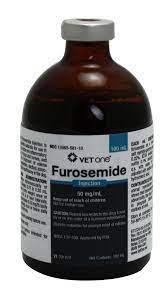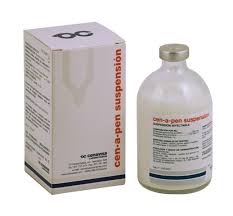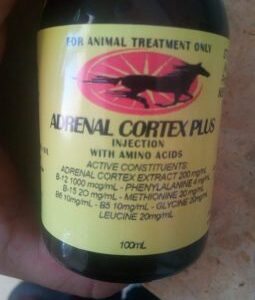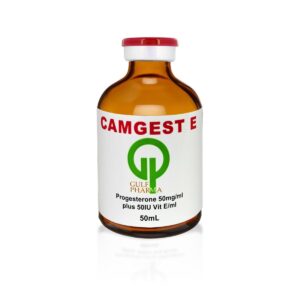Furosemide Injection (50 mg/mL) is a potent loop diuretic that is a derivative of anthranilic acid. It is an effective diureticsaluretic for use in the treatment of acute non-inflammatory tissue edema in dogs and horses, and for use in the treatment of edema (pulmonary congestion, ascites) associated with cardiac insufficiency in dogs. Administer IV or IM.
ITEM# DESCRIPTION SIZE
501070 Furosemide Injection 100 mL
CAUTION: Federal law restricts this drug to use by or on
the order of a licensed veterinarian.
DESCRIPTION: Furosemide is a potent loop diuretic
which is a derivative of anthranilic acid. The structure is:
Chemical Name: 4-Chloro-N-furfuryl-5-sulfamoylan
thranilic acid. Furosemide is pharmacodynamically characterized by the following.
1) Administered intramuscularly, it begins to act in about
30 minutes, and diuretic response is produced. When
administered intravenously, the response is in about 5
minutes.1 2
2) Is a loop diuretic which inhibits reabsorption of sodium
and chloride at the ascending loop of Henle in the kidneys, enhancing water excretion.3
3) A dose-response relationship and a ratio of minimum
to maximum effective dose range greater than tenfold.1
4) A high degree of efficacy, low inherent toxicity and a
high therapeutic index.
EACH ML CONTAINS: 50 mg furosemide as a monoethanolamine salt, myristyl-gamma-picolinium chloride
0.02%, EDTA sodium 0.1%, sodium sulfite 0.1% with
sodium chloride 0.2% in water for injection, pH adjusted
with sodium hydroxide and/or hydrochloric acid.
ACTIONS: The therapeutic efficacy of Furosemide Injection is from the activity of the intact and unaltered molecule throughout the nephron, inhibiting the reabsorption of sodium not only in the proximal and distal tubule
but also in the ascending limb of the loop of Henle. The
prompt onset of action is a result of the drug’s rapid absorption and a poor lipid solubility. The low lipid solubility
and a rapid renal excretion minimize the possibility of its
accumulation in tissues and organs or crystalluria.
Furosemide has no inhibitory effect on carbonic anhydrase or aldosterone activity in the distal tubule. The drug
possesses diuretic activity either in the presence of acidosis or alkalosis.1 3 4 5 6
INDICATIONS: Dogs and Horses: Furosemide Injection is
an effective diuretic-saluretic for use in the treatment of acute
noninflammatory tissue edema in dogs and horses, and for
use in the treatment of edema (pulmonary congestion, ascites) associated with cardiac insufficiency in the dog.
In cases of edema involving cardiac insufficiency, the
continued use of heart stimulants such as digitalis or its
glycosides is indicated.
The rationale for efficacious use of diuretic therapy in either dogs or horses is determined by the clinical pathology producing the edema.
DOSAGE AND ADMINISTRATION: Dogs-Administer
intravenously or intramuscularly 0.25 to 0.50 mL per
10 pounds body weight once or twice daily at 6 to 8
hour intervals.
The dosage should be adjusted to the individual’s response. In severe edematous or refractory cases, the
dose may be doubled or increased by increments of 1.0
mg per pound of body weight.
The established effective dose should be administered
once or twice daily.
Discontinue diuretic therapy with Furosemide Injection,
50 mg/mL after initiation of acute fluid mobilization or
stabilization of patient; when necessary Furosemide Tablets may be used for maintenance therapy (see Furosemide Tablets insert for details). Do not exceed treatment
with Furosemide Injection, 50 mg/mL for more than 3
days. The daily schedule of administration can be timed
to control the period of micturition for the convenience of
the client or veterinarian.
Mobilization of the edema may be most efficiently and
safely accomplished by utilizing an intermittent daily dose
schedule, i.e., every other day or 2 to 4 consecutive days
weekly.
Horses-The usual parenteral dosage of furosemide in
horses is approximately 0.5 mg/lb body weight (1.0 mg/
kg). See dosage schedule below. A prompt diuresis usually ensues from the initial treatment. Administer once or
twice daily at 6 to 8 hour intervals either intravenously or
intramuscularly until desired results are achieved.
The dosage should be adjusted to the individual’s response. In severe edematous or refractory cases, the
dose may be doubled or increased by increments of 0.5
mg per pound of body weight.
The established effective dose should be administered
once or twice daily. The daily schedule of administration
can be timed to control the period of micturition for the
convenience of the client or veterinarian.
Mobilization of the edema may be most efficiently and
safely accomplished by utilizing an intermittent daily dose
schedule, i.e., every other day or 2 to 4 consecutive days
weekly.
RECOMMENDED DOSAGE SCHEDULE: Horses: Administer IV or IM once or twice daily at 6-8 hour intervals
until desired results are achieved.
Diuretic therapy for both dogs and horses should be
discontinued after reduction of the edema, or maintained after determining a carefully programmed dosage schedule to prevent recurrence of edema. For long-term treatment, the dose can generally be lowered after the edema has once been reduced. Re-examination and consultations with the client will enhance the establishment of a satisfactorily programmed dosage schedule. Clinical examination and serum BUN, CO2 and electrolyte determinations should be performed during the early period of therapy and periodically thereafter, especially in refractory cases. Abnormalities should be corrected or the drug temporarily withdrawn. CONTRAINDICATIONS: Animal reproductive studies have shown that furosemide may cause fetal abnormality and the drug is contraindicated in pregnant bitches, mares and stallions at stud. Furosemide is contraindicated in anuria, furosemide hypersensitivity, hepatic coma, or during electrolytic imbalances. Monitor serum electrolytes, BUN and CO2 frequently. Monitor serum potassium levels and watch for signs of hypocalcemia. Corticosteroids cause an additive potassium-depletion effect. WARNINGS: Furosemide Injection is a highly effective diuretic and, if given in excessive amounts, as with any diuretic, may lead to excessive diuresis which could result in electrolyte imbalance, dehydration and reduction of plasma volume, enhancing the risk of circulatory collapse, thrombosis and embolism. Therefore, the animal should be observed for early signs of fluid depletion with electrolyte imbalance, and corrective measures administered. Excessive loss of potassium in patients receiving digitalis or its glycosides may precipitate digitalis toxicity. Caution should be exercised in animals administered potassium-depleting steroids. Correct potassium deficiency with proper dietary supplementation. If animal needs potassium supplements, use oral liquid form; do not use enteric-coated potassium tablets. The concurrent use of furosemide with some antibiotics may be inadvisable. There is evidence that the drug enhances the nephrotoxic potential of aminoglycosides, cephalosporins and polymyxins and increases the ototoxic effects of all aminoglycosides. Sulfonamide diuretics have been reported to decrease arterial responsiveness to pressor amines and to enhance the effect of tubocurarine. Caution should be exercised in administering curare or its derivatives to patients undergoing therapy with Furosemide Injection and it is advisable to discontinue Furosemide Injection for one day prior to any elective surgery. Do not use in horses intended for human consumption. PRECAUTIONS: Furosemide Injection is a highly effective diuretic-saluretic which, if given in excessive amounts, may result in dehydration and have to be adjusted to the patient’s needs. The animal should be observed for early signs of electrolyte imbalance, and corrective measures administered. Early signs of electrolyte imbalance are increased thirst, lethargy, drowsiness or restlessness, fatigue, oliguria, gastro-intestinal disturbances and tachycardia. Special attention should be given to potassium levels. Furosemide Injection may lower serum calcium levels and cause tetany in rare cases of animals having an existing hypocalcemic tendency.7 8 9 10 11 Furosemide Injection is contraindicated in anuria. Therapy should be discontinued in cases of progressive renal disease if increasing azotemia and oliguria occur during the treatment. Sudden alterations of fluid and electrolyte imbalance in an animal with cirrhosis may precipitate hepatic coma, therefore, observation during period of therapy is necessary. In hepatic coma and in states of electrolyte depletion, therapy should not be instituted until the basic condition is improved or corrected.Potassium supplementation may be necessary in cases routinely treated with potassium-depleting steroids. Active or latent diabetes mellitis may on rare occasions be exacerbated by furosemide. Transient loss of auditory capacity has been experimentally produced in cats following intravenous injections of excessive doses of furosemide at a very rapid rate





Reviews
There are no reviews yet.